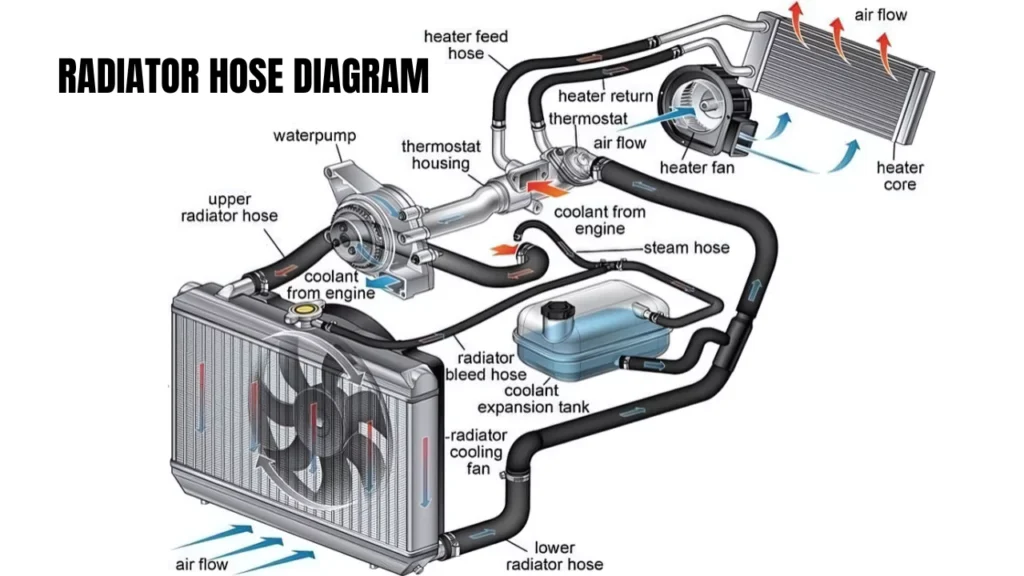Cooling system hoses transport coolant or antifreeze throughout the engine, heater, and radiator. This complex network of hoses circulates coolant from the radiator to the hottest part of the engine, then returns the overheated fluids back to the radiator to release the heat and repeat the cycle.
The radiator contained upper and lower hoses, which are the widest hoses used in the system. Through the lower, the coolant is transferred to the engine and follows the upper hose back to the radiator for cooling. So, the upper radiator hose is designed to withstand heat.
What Is a Cooling System Hose?
A cooling system hose is typically a rubber component that is designed to convey the flow of coolant from one spot to another to ensure proper circulation of coolant around the engine.
Modern automobile cooling systems contain many hoses with various purposes; although they look complex, their working is ideal. These hoses will be further explained.
The basic automobile cooling system hoses are the upper and lower radiator hoses. These hoses look the same, but they cannot be interchanged because they are designed for different purposes, just as already stated.
Other functional hoses include the overflow tank hose, heater core hose, and thermostat hose. These hoses are fitly tight with fittings to other parts of the engine.
Functions of Hose
Below are the functions of the hose in automobile cooling system:
- The primary purpose of a hose is to carry the coolant through the engine at an optimal temperature.
- Its design withstands the vibration produced by the engine.
- With the hose, coolant bypasses the radiator and returns to the engine.
- The pressure cap bled off hot coolant to the overflow tank. This prevents the cooling system from being damaged or leaking.
radiator hose diagram:

Types of Cooling System Hoses
Below are the various types of hose used in various automobile cooling system components:
Lower Hose:
The lower hose is one of the large hoses that cannot absorb intense heat from the coolant. It’s located at the bottom of the radiator and connected to the engine water pump housing. Through the hose, cold coolant is transferred into the engine, as the water pump also plays a role.
Upper Hose:
These types of hose are the other large hose located at the top side of the radiator. they are designed to absorb intense heat from the coolant since only hot coolant is allowed to pass through them. This is why the upper and lower hoses cannot be interchanged.
As coolant absorbs the heat produced during the combustion process, it passes through the upper hose back to the radiator, so cooling can occur. The upper hose is known as the heater hose.
Bypass Hose:
The thermostat ensures that the coolant reaches a specific temperature before entering the radiator. If the temperature has not yet reached, a bypass hose allows the coolant to return to the engine.
The thermostat remains locked, blocking the coolant if the temperature is not yet obtained to open the valve. So, the coolant bypasses the radiator as it follows the hose.
Overflow Hose:
The overflow hose types connect the radiator pressure cap and the overflow tank. As pressure happens to the hot coolant in the radiator and its expansion, the pressure cap opens, and the hot coolant is bled off. The coolant follows through the overflow hose to the tank. This hose is also a heater hose.
Symptoms of Bad or Failing Radiator Hose
Below are the common signs or symptoms of a bad and failing radiator hose:
Leaking Coolant:
if you have a leaking hose, you will see coolant beneath your vehicle. This fluid has a sweet smell.
Leaking coolant can also be from the radiator itself, which is why a professional mechanic should diagnose the problem. If the hose is diagnosed as a problem, consider a replacement.
Engine Overheating:
If coolant circulation is obstructed, the engine will overheat. As soon as you notice any overheating symptoms, then your cooling system is faulty.
In this situation, the hose may not be the issue, but it is one of the most common causes of overheating. You should quickly reach out to your mechanic to fix the issue, as this issue can cause a complete breakdown of the engine.
Low Coolant:
The warning light turns on if this issue occurs as you keep topping up the radiator with coolant. There is a leak in the hose that pouring away the coolant. the leak will be obvious as drops when the vehicle is parked.
Risking the drive of such a vehicle can damage its components before reaching the destination, as the engine can stall or overheat.
Damaged Radiator Hose:
A damaged radiator hose is soft and has become weak. You’ll notice this if you touch the hose. A problem with the complete cooling system will cause the hose to collapse. A general inspection or maintenance should be carried out if you notice this issue.
A damaged hose won’t be able to flow coolant properly, which may result in overheating and engine damage.
Broken Radiator Hose:
A broken radiator hose is a sensitive problem that must be carefully examined. It combines checking for leaks, swellings, collapses, cracks, holes, or soft portions in the hose.
A professional should consider doing this or a DIYer who can take his time doing such. Consider changing the hose if confirmed with any of the listed issues.